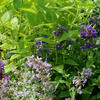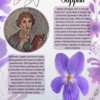
Sappho (6th Century B.C.E.)
- Sappho (Σαπφώ), born in early 6th Century B.C. on the Island of Lesbos, was a prominent figurehead in the realm of early Greek poets. While few details are known of her life, it is believed she was a part of an aristocratic family. Her work was lyric poetry was written in the Aeolic dialect, meant to be sung for her circle of acquaintances who were usually women. Sappho’s poetry is distinguished by her passionate love of women, adoration of nature, and a blunt simplicity. Particularly, Sappho was fond of violets, gifting garlands and crowns of violets to potential lovers. While all but one of her poems have become lost to time, Sappho's influence today can be seen in the terms sapphic, and lesbian-both used to denote love between women

Oscar Wilde (1854 – 1900)
- Oscar Fingal O'Flahertie Wills Wilde was an Irish playwright and poet. Renowned for both his famous writing and for his flamboyant presence, Wilde made a resounding impact on the literary scene with the strong aestheticism present in his work. Wilde’s sexuality was known amongst his contemporaries through rumor but was brought into the public eye through a trial in which Wilde brought a criminal libel case against the Marquess of Queensberry. Through this case evidence was unearthed of Wilde’s then illegal sexuality and he was arrested for gross indecency due to his relations with other men. Wilde was sentenced to two years hard labor, the maximum punishment for the offence. Never fully recovering from his incarceration, Wilde passed away from meningitis while in exile. Today, Wilde is recognized as one of the literary greats of the Victorian Era.
Hilda Doolittle (HD) (1886-1961)
- Hilda Doolittle (H.D.) was an American poet born in Bethlehem, Pennsylvania on September 10. 1886. Her poetry, which often incorporated vivid metaphors to the natural world, quickly placed her as one of the leaders of the burgeoning Imagist Movement. Throughout her life, she publicly pursued relationships with both men and women, being an “out” bisexual in an age where that was unheard of. Her work is still celebrated and published today.
Vita Sackville-West (1892-1962)
- Vita Sackville-West was an accomplished writer and garden designer. While married to diplomat Sir Richard Nicolson, they were in an open marriage, and both pursued homosexual relationships. Sackville-West was engaged in a decade long relationship with fellow writer Virginia Woolf. While known best today for her gardens, such as Sissinghurst Castle Garden, during her time she was considered an even greater writer than Woolf herself. Sackville-West wrote the work “A Portrait of a Marriage" in hopes to explain bisexuality to the general public. Today, Sissinghurst Castle Garden is owned by the National Trust of England and is preserved as a national landmark.
Barbara Gittings (1932 – 2007)
- Barbara Gittings was an activist in the Gay Liberation Movement. A Philadelphia native, Gittings was involved in some of the earliest gay rights protests in the nation. Picketing the Whitehouse in 1965, Gittings brought the fight back to Philly and protested the federal discrimination of gay people in front of independence hall. This action began “The Annual Reminder,” a series of protests homophobia that lasted until 1965. Barbara Gittings tireless work laid the foundation for the modern LGBTQ+ Rights movement and her impact is seen today in many anti-discrimination laws.

The Lavender Menace (1970)
- First uniting on May 1, 1970, the Lavender Menace were an informal group of lesbian and bisexual women protesting exclusion within mainstream feminism. Deriving their name from a speech in which Betty Friedan, the president of the National Organization for Women, deemed sapphic women in feminism a “lavender menace,” they quickly united and planned a political action for the Second Congress to Unite Women. Crashing the opening ceremony of the Congress, The Lavender Menace had timed for the lights to go out and the microphone to cut. When the lights returned, the aisles of the Congress were lined with activists in matching shirts reading “LAVENDER MENACE.” After a small skit was performed by Rita Mae Brown, one of the main organizers of the protest, copies of the group’s manifesto The Woman-Identified Woman were dispersed. Today, The Lavender Menace's protest is recognized as a turning point in Second Wave Feminism.
Mary Oliver (1935 – 2019)
- Mary Oliver was born in Maple Heights, Ohio on September 10, 1935. From an early age, Oliver spent most of her time outside. These early childhood nature walks shaped her literary career, with plain language poems about the wonder of the outdoors becoming her signature. Oliver met her soulmate Molly Malone Cook in the 1950’s and the two spent their lives together in Provincetown, Massachusetts. In 2007, Mary Oliver was the bestselling poet in America. Mary Oliver passed away on January 17, 2019. Through over 30 published works, Oliver inspired a deep love of nature in generations of readers.
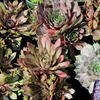
Exhibit Plants
The plants chosen for this exhibit are symbolic to the LGBTQ movement through history or, given the significance of the color purple to the movement, various ways to incorporate purple through foliage and flowers in your garden throughout the seasons.
Achillea – Yarrow – there are many varieties of yarrow to choose from. Generally reliable perennial plants for early summer color, while their flowers do not come in purple, yarrow has featured prominently
Acorus gramineus ‘Minimus aureus’ - this dwarf version of Grassy-leaved sweet flag features yellow leaves that top out at just 3-4” tall but will eventually spread to form a mat of golden sweetly-secnted foliage.
Astilbe chinensis var. pumila – lilac plumes of flowers stand tall over glossy foliage in late summer, more tolerant of sun and drought than other astilbe.
Astilbe x rosea ‘Peach Blossom’ - light rose blooms beginning in late June are perfect on this perennial well suited for brightening up a shady garden.
Baptisia australis – Native perennial with purple pea-like flowers in spikes atop blue green foliage. Deer resistant and makes a great cut flower.
Brugmansia suaveolens cv – Angel’s trumpet, a tropical shrub known for its fragrant pendulous white flowers, great for containers and should be brought indoors to overwinter.
Calamagrostis x acutiflora ‘Karl Foerster’- this variety of Feather Reed Grass is popular for its well-behaved habit, remaining upright and narrow and getting 5’ tall.
Caryopteris x clandonensis ‘Beyond Midnight’ – deep blue flowers that bloom well into the fall and dark glossy foliage set this apart from other Bluebeards, like other bluebeards the pollinators cannot stay away.
Centaurea montana ‘Amethyst Dream’ – Low mounding gray green leaves are topped with shaggy early summer flowers in a deep purple. Full sun to part shade, so far deer resistant at the Ambler Arboretum.
Clematis ‘EVIPO039’ – Diamantina Clematis – wow! We were stopped in our tracks when we saw this lovely which is ultimately destined for the Arboretum’s new vine display. 4-6” pom-pom like double flowers last for weeks.

Cotinus coggygria ‘Ancot’ – A golden-leaved smoke bush that turns shades of orange and red in the fall.
Cotinus coggygria - Purple Smokebush, named for its purple leaves and the smoke-like flower clusters that sit high atop the foliage in the late spring.
Dianthus gratianopolitanus ‘Feuerhexe’ – Firewitch Cheddar Pink is an evergreen perennial with a clove fragrance emitting from the brilliant pink flowers. Grassy blue gray foliage fills into mats providing a nice backdrop as the flowers rebloom sporadically throughout the growing season.
Euphorbia ‘KM-MM024’ Miners Merlot – Miner’s Merlot Wood Spurge adds dramatic deep purple foliage to the landscape in 2’ x 2’ mounds. Tends to be evergreen and is hardy in zones 6-11. Long-lasting chartreuse flowers add another dimension of seasonal interest.
Ipomoea batatas ‘Blackie’ - this Sweet Potato vine will create tubers that you can dig up and store, allowing you to incorporate the nearly black foliage into your garden year after year. The Ambler Arboretum deer do find this plant quite tasty and snack on it regularly.
Lagerstromia indica – a large shrub or small tree, there are a few cultivars featuring lavender or purple blooms. The season of interest extends beyond the summer flowers with the unique exfoliating bark.
Lavandula x ginginsii – a less hardy cultivar of lavender that must be brought indoors for winter, features silvery-grey leaves with tall spikes of deep purple flowers over a long bloom season. Its compact shape makes it great for containers.
Lavandula angustifolia ‘Hidcote’ – a compact perennial topping out at 24” tall, hardy zones 5-9, like all lavenders needs well drained soils, deer resistant and drought tolerant once established.
Lavandula stoechas ‘Primavera’ - sometimes called the most fragrant lavender, Spanish lavender, is extraordinarily heat tolerant and continue to bloom even in the hottest weather. This upright compact cultivar features purple flowers with reddish-purple flags. This cultivar is not reliable hardy in this region.
Lavandula x intermedia ‘Grosso’ - French lavender grown for fragrant dark purple flower spikes and wide gray-green foliage.
Lavandula x intermedia ‘Niko’ Phenomenal – upright, compact with clusters of purple flowers on upright stalks to 1’ tall above silvery foliage. Deer tolerant and hardy zones 5-8.
Lavandula x intermedia ‘Tesseract’ Scentsational! – Broad, bright silver leaves and large 4” flowers sets this lavender apart from the others. Enjoy the blooms on this hardy perennial summer through fall.
Leptinella squalida ‘Platt’s Black’ - Also known as Brass Buttons, tiny fern-like foliage in a combination of bronze and green spread quickly on this hardy perennial groundcover, eventually forming mats of foliage.
Leptodermis oblonga – A dwarf mounding deciduous shrub growing only 18” tall. Fragrant tubular lavender flowers appear throughout the growing season.
Nepeta ‘Cat’s Pajamas’- this Catmint blooms a couple of weeks before other catmint cultivars and keeps blooming for quite sometime above the petite mounds of foliage. Only growing to 14” tall and preferring full sun and hot sites this a perfect rock garden or xeriscape plant.
Nepeta racemosa ‘Walker’s Low’ - Growing to 30” tall, this hardy perennial gets covered with blue violet flowers held above the gray green foliage. Floriferous is the best word to describe this long season bloomer.
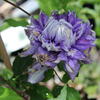
About the Ambler Arboretum’s Philadelphia Flower Show Exhibit
Designers and Installers:
- Danny Logue
- Grace Lenart
- Frankie Napolie
- Emilia Zabagay
Throughout history, members of the LGBTQ community have found inspiration and emotional wellbeing in the natural world. Designed by four members of the Temple Ambler Arboretum’s student gardener team, education and awareness were centered early in the design process.
In our research, the extent of the LGBTQ community’s connection to the natural world surprised our team. Going back to some of the earliest passages of Queer History, plants have served as community uniters and rallying symbols. Our display centers a writer’s desk emblazoned with quotes from famous authors, poets, and botanists from the community.
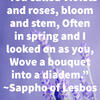
Flanked on both sides by a long, undulating bed: the plantings seek to bring to life the peaceful nature scenes referenced within the quotations. A wood chip path leading to the desk invites viewers to step into the shoes of these famous authors, botanists, and artists.: to feel inspiration surge as they are enveloped by the natural world.
Following in tow with the Ambler Arboretum’s commitment to sustainability, much of the materials used in this exhibit were repurposed materials from the Ambler Campus. Wooden easels flank each side of the exhibit, providing insight and further education to the symbols and imagery presented in the display.
Logs pop up through the display, serving as benches, planters, or end tables. These logs were sourced directly from the Arboretum. Some of these logs are from trees downed by the EF2 Tornado that hit Ambler on September 1, 2021. In this way, we honor the trees that generations of students have learned from by extending their life.
We hope that through botanic samples, compact educational signage, and specific quotations, the viewer is left with a deeper understanding of the people and plants around them.
As the great unifier, nature serves as a nonjudgmental space where everyone is welcome to bask in the sun. Certainly, to be ‘In Full Bloom” means to be open and visible as your full authentic self.

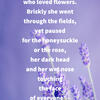
Resources
Queer Support and Resources
The Trevor Project - https://www.thetrevorproject.org/
The Attic Youth Center - https://atticyouthcenter.org/
Galaei - https://www.galaeiqtbipoc.org/
The Mazzoni Center - https://www.mazzonicenter.org/
The William Way Community Center - https://www.waygay.org/
The Tornado that Damaged the Ambler Arboretum and Surrounding Communities:
https://www.inquirer.com/education/temple-university-ambler-tornado-damage-ida-20210917.html
https://www.inquirer.com/newsletters/morning/ida-remnants-resources-made-in-america-20210917.html
https://news.temple.edu/news/2021-09-22/road-recovery-begins
References for the relationship between queer people and botany:
Queer the Table Podcast: https://heritageradionetwork.org/series/queer-table
Chelsea Physics Garden Display on Queer Botany: https://www.chelseaphysicgarden.co.uk/visit/whats-on/a-dash-of-lavender-lgbtq-month-at-chelsea-physic-garden/
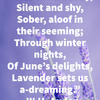
History of lavender influencing pop culture in 1920s Berlin : The Lavender Song (Das Lila Lied) | Facing History and Ourselves : https://www.facinghistory.org/resource-library/audio/lavender-song-das-lila-lied
A few translated Sappho poems, Poem 105c referring to hyacinths : https://login.libproxy.temple.edu/login?qurl=https://www.jstor.org/stable/40742314
Maybe one of the most referenced Sappho poems, Sappho 94, references l, violets, and crocuses : https://login.libproxy.temple.edu/login?qurl=https://www.jstor.org/stable/43863819
Another reference to Hyacinths and the color purple in Sapphos work, poem 151 : https://login.libproxy.temple.edu/login?qurl=https://www.jstor.org/stable/27535302
Green carnation and its symbolic beginnings: Green carnation – https://lgbthistoryuk.org/wiki/Green_carnation
Philidelphian Barbara Gittings and her role in the LGBTQ civil rights movement:
https://library.citadel.edu/c.php?g=895598&p=6441419
https://lgbt50.org/barbara-gittings
Throughout her life Emily Dickenson was an avid herbarium keeper. She was most famous for gardening during her life
https://edsitement.neh.gov/student-activities/flowers-emily
https://www.themarginalian.org/2017/05/23/emily-dickinson-herbarium/

